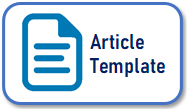Distribution Pattern and Mapping of Invasive Alien Species Bellucia pentamera in Conservation Area of PT. Tidar Kerinci Agung (TKA) Solok Selatan
Abstract
Bellucia pentamera is one of the most dangerous invasive alien species for environment. This species had been invaded many forests in Indonesia. This species would invade more area due to deforestation. The objectives of this study were to know the mapping and distribution pattern of B. pentamera; to know the effects of distance from road and light intensity to distribution of B. pentamera. This study was conducted from March to August 2020 in Conservation Area of PT. TKA Solok Selatan using belt transect method by plotting 20x50 m2. Data was analyzed using Morishita Index and Linear Regression. Distribution pattern of B. pentamera in PT. TKA was clumped, showed by 1.17 of Morishita index. Seedlings and saplings of B. pentamera were dominant at the edge of conservation forest while trees were distributed from the middle to inside of the forest. Distance from road gave positively effects and significantly towards distribution of B. pentamera showing result 0.702 of R2 and 0.007 of p-Value. Light intensity did not give effects significantly towards distribution of B. pentamera showing result 0.0806 of R2 and 0.427 of p-Value.
Keywords
Full Text:
PDFReferences
Aji I.M.L., Sutriono R., Yudistira, 2015. Pengaruh Media Tanam dan Kelas Intensitas Cahaya Terhadap Pertumbuhan Benih Gaharu (Gyrinops versteegii). Jurnal Media Bina Ilmiah. 9(5) : 1-10.
Ariyanti, EE dan Mudiana, D. 2018. Vegetasi Tumbuhan Blok Hutan Waru Waru Cagar Alam Pulau Sempu. Media Konservasi. 23(3): 244-252.
Azizah, E. 2017. Kerapatan dan Biomassa Lamun Enhalus acoroides di Perairan Desa Jago-Jago Tapanuli Tengah Provinsi Sumatera Utara. Fakultas Perikanan dan Kelautan Universitas Riau. Pekanbaru.
Barbour SL, Lam L, Fredlund DG. 1987. Transient Seepage Model for Saturatet-Unsaturated Soil Systems: A Geotechnical Engineering Approach. J. Can Geotech. 24(198): 565-580.
de Kok, R. P, M. Briggs, D. Pirnanda, and D. Girmansyah. 2015. Identifying targets for plant conservation in Harapan rainforest, Sumatra. Tropical Conservation Science. 8:28:-32.
Dillis, C. Andrew J.M., Marcel R. 2017. Change in distrubance regime facilitates invasion by Bellucia pentamera Naudin (Melastomaceae) at Gunung Palung National Park, Indonesia. Bioloical Invasions.19:1329-1337.
Djufri. 2011. PengaruhTegakan Akasia (Acacia nilotica) (L.) Willd. Ex. Del. Terhadap Komposisi dan Keanekaragaman Tumbuhan Bawah di Savana Balanan Taman Nasional Baluran Jawa Timur. Jurnal Ilmiah Pendidikan Biologi. 3(2): 38-50.
Dombois, Muller D dan Ellenberg. 1974. Aims and Methods of Vegetation Ecology. John Wiley and Sons. New York.
Fei S, Kong N, Stringer J, Browker D. 2009. Invasion Pattern of Exotic Plants in Forest Ecosystems. Di dalam: Kohli RK, Jose S, Singh HP, Batish DR, editor. Invasive Plants and Forest Ecosystem. New York: CRC Press.
Hartson, GS. 1980. Neotropical Forest Dinamics. Dalam: Tropical Succesion. John E Suplement. Biotropica. 12(2): 23-30.
IUCN(International Union for Conservation of Nature and Natural Resources). 2000. IUCN Guidelines for the Prevention of Biodiversity Loss Caused by Alien Invasive Species.Gland (CH): IUCN Council.
Krebs, CJ. 2013. Ecological Methodology. Ed ke-3. Harper & Row. New York.
Kusmana, C &Agus, H. 2015. Keanekaragaman Hayati Flora di Indonesia (The Biodiversity of Flora in Indonesia). Jurnal Pengelolaan Sumber daya Alam dan Lingkungan. 5(2):187-198.
McNaughton SJ, Wolf LL. 1990. Ekologi Umum. Gadjah Mada University Press.Yogyakarta.
Metananda, AA., ErvizalAmz., Agus H. 2015. Populasi, Sebaran dan Asosiasi Kepuh (Sterculia foetida L.) di Kabupaten Sumbawa Nusa Tenggara Barat. Media Konservasi. 20(3): 277-287.
Moris WK, Hansen MH, Nelson MD, & McWiliams W. 2009. Relation of Invasive Groundcover Plant Presence to Evidence of Disturbance in the Forest of the Upper Midwest of the United States. Di dalam: Kohli RK, Jose S, Singh HP, Batish DR, editor. Invasive Plants and Forest Ecosystem.CRC.
Peraturan Menteri Lingkungan Hidup dan Kehutanan Republik Indonesia. 2016. (PERMENLHK) No. P.94/MENLHK/SETJEN/KUM. Tentang Jenis Invasif
Rani, C. 2003. Metode Pengukuran Dan Analisis Pola Spasial (Dispersi) Organisme Bentik.Jurusan Ilmu Kelautan, Fakultas Ilmu Kelautan dan Perikanan-UNHAS. Makassar.
Renner, S.S. 1986. Reproductive Biology of Bellucia (Melastomataceae). Acta Amazônica.16/17: 197-208.
Sastroutomo, SS. 1990. Ekologi Gulma. Gramedia Pustaka Utama. Jakarta
Serna, DMO dan José HIM. 2015. Phenolics and Polyphenolics from. Melastomataceae Species. Journal Molecules. 20 (10): 17818-17847.
Simbolon, R. S. 2013. Keanekaragaman dan Pola Sebaran Spesies Tumbuhan Asing Invasif di Cagar Alam Dungus Iwul, Bogor. Skripsi. Fakultas Kehutanan. Institut Pertanian Bogor. Bogor.
Smith, P.G. 1964. Quantitative Plant Ecology Second Edition. Butterworths. London.
Solfiyeni. 2019. Dampak Invasi Tumbuhan Asing Invasif Bellucia pentamera Naudin terhadap Keanekaragaman Sapling dan Tumbuhan Bawah di Hutan Konservasi Perkebunan Kelapa Sawit. Prosiding Seminar BIOETI Jurusan Biologi Universitas Andalas. 20-21 September 2019.
Sutoyo, 2010. Keanekaragaman Hayati Indonesia. Buana Sains.10(2):10-06.
Tim NKT (HCV) PT. TKA. 2013. Identifikasi Kawasan Bernilai Konservasi Tinggi, High Conservation value (HCV). PT. TidarKerinci Agung. Sumbar-Jambi.
Yani, E. 2006. Struktur dan Kemampuan Tumbuh Kembali Hutan Mangrove Cikiperan Cilacap. Biosfera.23(3): 124-129.
Refbacks
- There are currently no refbacks.




